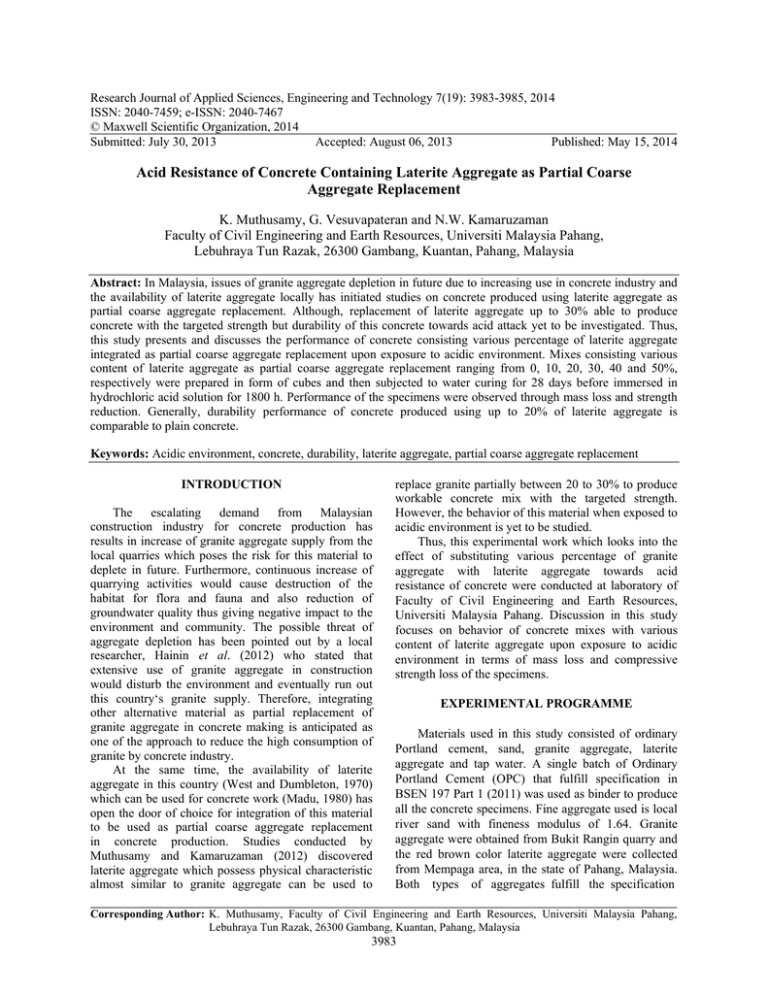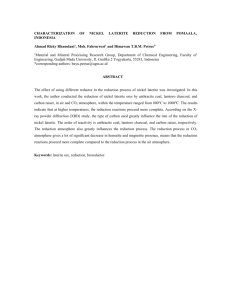Research Journal of Applied Sciences, Engineering and Technology 7(19): 3983-3985,... ISSN: 2040-7459; e-ISSN: 2040-7467
advertisement

Research Journal of Applied Sciences, Engineering and Technology 7(19): 3983-3985, 2014 ISSN: 2040-7459; e-ISSN: 2040-7467 © Maxwell Scientific Organization, 2014 Submitted: July 30, 2013 Accepted: August 06, 2013 Published: May 15, 2014 Acid Resistance of Concrete Containing Laterite Aggregate as Partial Coarse Aggregate Replacement K. Muthusamy, G. Vesuvapateran and N.W. Kamaruzaman Faculty of Civil Engineering and Earth Resources, Universiti Malaysia Pahang, Lebuhraya Tun Razak, 26300 Gambang, Kuantan, Pahang, Malaysia Abstract: In Malaysia, issues of granite aggregate depletion in future due to increasing use in concrete industry and the availability of laterite aggregate locally has initiated studies on concrete produced using laterite aggregate as partial coarse aggregate replacement. Although, replacement of laterite aggregate up to 30% able to produce concrete with the targeted strength but durability of this concrete towards acid attack yet to be investigated. Thus, this study presents and discusses the performance of concrete consisting various percentage of laterite aggregate integrated as partial coarse aggregate replacement upon exposure to acidic environment. Mixes consisting various content of laterite aggregate as partial coarse aggregate replacement ranging from 0, 10, 20, 30, 40 and 50%, respectively were prepared in form of cubes and then subjected to water curing for 28 days before immersed in hydrochloric acid solution for 1800 h. Performance of the specimens were observed through mass loss and strength reduction. Generally, durability performance of concrete produced using up to 20% of laterite aggregate is comparable to plain concrete. Keywords: Acidic environment, concrete, durability, laterite aggregate, partial coarse aggregate replacement INTRODUCTION The escalating demand from Malaysian construction industry for concrete production has results in increase of granite aggregate supply from the local quarries which poses the risk for this material to deplete in future. Furthermore, continuous increase of quarrying activities would cause destruction of the habitat for flora and fauna and also reduction of groundwater quality thus giving negative impact to the environment and community. The possible threat of aggregate depletion has been pointed out by a local researcher, Hainin et al. (2012) who stated that extensive use of granite aggregate in construction would disturb the environment and eventually run out this country‘s granite supply. Therefore, integrating other alternative material as partial replacement of granite aggregate in concrete making is anticipated as one of the approach to reduce the high consumption of granite by concrete industry. At the same time, the availability of laterite aggregate in this country (West and Dumbleton, 1970) which can be used for concrete work (Madu, 1980) has open the door of choice for integration of this material to be used as partial coarse aggregate replacement in concrete production. Studies conducted by Muthusamy and Kamaruzaman (2012) discovered laterite aggregate which possess physical characteristic almost similar to granite aggregate can be used to replace granite partially between 20 to 30% to produce workable concrete mix with the targeted strength. However, the behavior of this material when exposed to acidic environment is yet to be studied. Thus, this experimental work which looks into the effect of substituting various percentage of granite aggregate with laterite aggregate towards acid resistance of concrete were conducted at laboratory of Faculty of Civil Engineering and Earth Resources, Universiti Malaysia Pahang. Discussion in this study focuses on behavior of concrete mixes with various content of laterite aggregate upon exposure to acidic environment in terms of mass loss and compressive strength loss of the specimens. EXPERIMENTAL PROGRAMME Materials used in this study consisted of ordinary Portland cement, sand, granite aggregate, laterite aggregate and tap water. A single batch of Ordinary Portland Cement (OPC) that fulfill specification in BSEN 197 Part 1 (2011) was used as binder to produce all the concrete specimens. Fine aggregate used is local river sand with fineness modulus of 1.64. Granite aggregate were obtained from Bukit Rangin quarry and the red brown color laterite aggregate were collected from Mempaga area, in the state of Pahang, Malaysia. Both types of aggregates fulfill the specification Corresponding Author: K. Muthusamy, Faculty of Civil Engineering and Earth Resources, Universiti Malaysia Pahang, Lebuhraya Tun Razak, 26300 Gambang, Kuantan, Pahang, Malaysia 3983 Res. J. App. Sci. Eng. Technol., 7(19): 3983-3985, 2014 Mass loss ( %) Site A 1.07 8.50 8.00 2.54 30.70 10.20 28.70 0.52 outlined in BSEN 12620 (British Standard Institute, 2008) that enables it to be used as coarse aggregate in concrete making. The physical properties of granite aggregate and laterite aggregate used in this study are shown in Table 1. Cube specimens (150×150×150 mm) used in this study consist of two types of mixes namely plain concrete and laterite concrete. Initially, plain concrete of Grade 30 were prepared using DOE method. The plain concrete that act as control specimen were produced using 100% granite aggregate as coarse aggregate. After that, laterite concrete were prepared by integrating a range of laterite aggregate content as partial coarse aggregate replacement. The laterite aggregate replacement used is from 10 to 50 with 10% interval. All specimens were demoulded after 24 h before subjected to water curing for 28 days prior to immersing them into hydrochloric acid solution for 1800 h. The pH of the solution was controlled to about 2 throughout the immersion period (Awal, 1998). The durability performance of both plain and laterite concrete mixes were determined by measuring the mass loss and reduction in compressive strength. 1.00 0.95 0.90 0.85 0.80 0.75 0.70 0.65 0.60 0.55 0.50 0 10 20 30 40 50 Laterite aggregate content (%) Fig. 1: Total mass loss of concrete consisting various percentage of laterite aggregate after submerged in hydrocloric acid solution for 1800 h Compressive strength (MPa) Table 1: Physical properties of granite and laterite aggregate Physical properties Granite Water absorption (%) 0.92 Flakiness index 6.30 Elongation index 6.10 Specific gravity 2.69 Aggregate crushing value (%) 28.80 Ten percent fines (%) 8.40 Aggregate impact value (%) 26.20 Moisture content (%) 0.45 60 55 50 45 40 35 30 25 20 15 10 5 0 Immersion in Water Immersion in HCL solution 0 10 20 30 40 50 Laterite aggregate replacement level (%) RESULTS AND DISCUSSION Fig. 2: Compressive strength of concrete consisting various percentage of laterite aggregate after submerged in tap water and hydrocloric acid solution for 1800 h Mass loss: The durability of concrete towards acid attack decreases as the percentage of laterite aggregate content integrated in the mix become larger as presented in Fig. 1 and 2. Mass loss and loss of strength which is among the signs of acidic attack (Zivica and Bajza, 2001) continues to be larger as the amount of laterite aggregate added in the mix increases. Plain concrete which produced using 100% granite aggregate exhibit the lowest total mass loss and strength reduction compared to other laterite concrete mixes. Integration of laterite aggregate up to 20% does not affect the specimen’s behavior much. The specimens experienced gradual mass loss and strength as laterite aggregate content added increases. However, beyond 20% replacement, concrete exhibit significant drop in both mass loss and strength value. Concrete produced using 50% of laterite aggregate is the most severely affected. Mass loss that occurs as a result of the leaching out of calcium chloride from the mortar due to reaction between calcium hydroxide in concrete with hydrochloric acid (Goyal et al., 2009) is higher in concrete containing larger percentage of laterite aggregate. This is because larger amount calcium salt which is soluble to water was formed and leached away due to action of acid towards calcium hydroxide in the particular specimens compared to the one produced using smaller amount of laterite aggregate. It was found the decomposition of larger amount of hydration product of cement matrix in the particular specimen causes loss of adhesion between aggregate particles on concrete surface to be higher thus resulting in more corner and edges losses. As the immersion become longer, the acid attack progresses from concrete surface to the internal part thus resulting in larger percentage of strength loss. Evidently, strength reduction and severity of physical damages is higher for the specimen produced using larger percentage of laterite aggregate. The deterioration process observed on the specimen is in line with the findings by Zivica and Bajza (2001) who highlighted that decrease in compressive strength of concrete is among the degradation process of concrete exposed to acid attack. Basically, the gradual reduction in concrete strength due to increase in the amount of 3984 Res. J. App. Sci. Eng. Technol., 7(19): 3983-3985, 2014 laterite aggregate integrated in the mix also diminishes the concrete durability to acid attack. Integration of laterite aggregate which properties slightly inferior from granite aggregate influence the acid resistance of concrete. This is not surprising since Limbachiya et al. (2012) has highlighted that aggregate plays important role in determining the strength and durability of concrete. CONCLUSION Based on the study it can be concluded that integration of laterite aggregate up to 20% replacement would produce concrete behaving almost similar to plain concrete. However, replacement of 40 and 50% is not recommended since it would significantly affect the durability of concrete to acid attack. ACKNOWLEDGMENT The authors gratefully acknowledge support of the staffs at Structure and Material Laboratory of Faculty of Civil Engineering and Earth Resources, Universiti Malaysia Pahang where the research was conducted. REFERENCES Awal, A.S.M., 1998. A study of strength and durability performances of concrete containing palm oil fuel ash. Ph.D. Thesis, Universiti Teknologi Malaysia, Skudai. British Standard Institute, 2008. Aggregates for Concrete. BS EN 12620, BSI, London, 56: 11-50. Goyal, S., M. Kumar, D.S. Sidhu and B. Bhattacharjee, 2009. Resistance of mineral admixture concrete to acid attack. J. Adv. Concr. Technol., 7(2): 273-283. Hainin, M.R., N.I.M. Yusoff, M.F.M. Sabri, M.A.A. Aziz, M.A.S. Hameed and W.F. Reshi, 2012. Steel slag as an aggregate replacement in Malaysian hot mix asphalt. ISRN Civil Eng., 2012: 1-5. Limbachiya, M., M.S. Meddah and Y. Ouchagour, 2012. Use of recycled concrete aggregate in fly ash concrete. Constr. Build. Mater., 27: 439-449. Madu, R.M., 1980. The performance of lateritic stones as concrete aggregates and road chippings. Mater. Construct., 13(78): 403-411. Muthusamy, K. and N.W. Kamaruzaman, 2012. Assessment of Malaysian laterite aggregate in concrete. Int. J. Civil Environ. Eng., 12(4): 83-86. West, G. and M.J. Dumbleton, 1970. The mineralogy of tropical weathering illustrated by some west Malaysian soils. Quart. J. Eng. Geol., 3: 25-40. Zivica, V. and A. Bajza, 2001. Acidic attack of cement based materials-a review.: Part 1. Principle of acidic attack. Constr. Build. Mater., 15: 331-340. 3985






